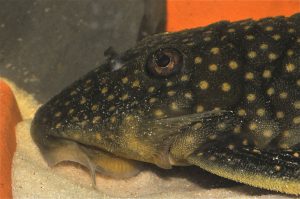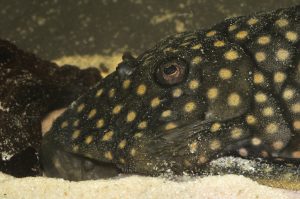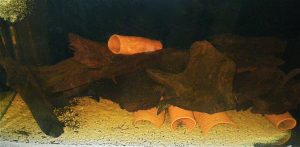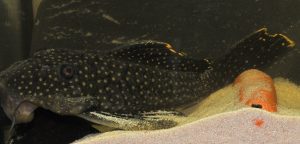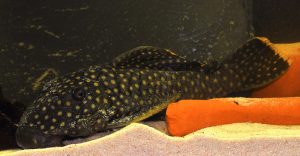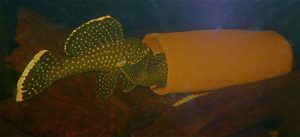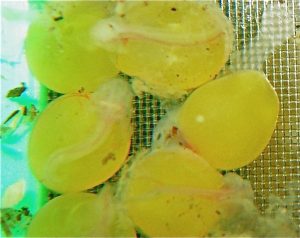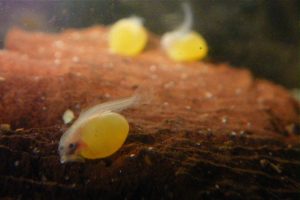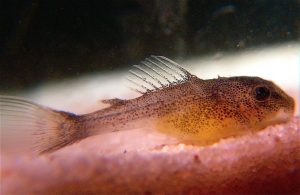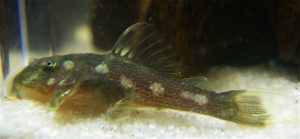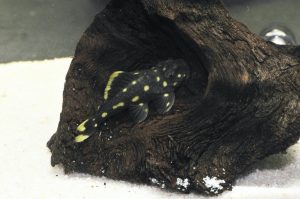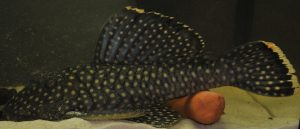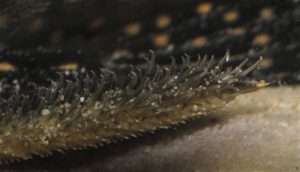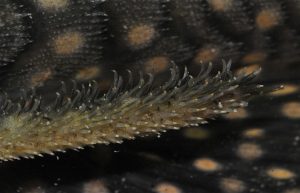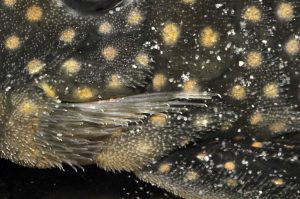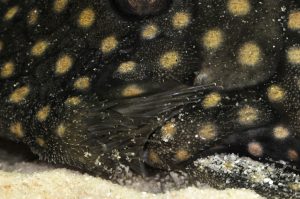At the 1st International L-Number-Days in 2009, Johannes LEUENBERGER reported for the first time on the successful reproduction of the ever-popular “golden nugget”. In the following years, aquarists tried again and again, but mostly unsuccessfully. Until 2021, when the Bellenz Fish Farm was able to report another success. The Bellenz Fish Farm is known for outstanding breeding successes (Scobinancistrus aureatus, L 368, Pseudacanthicus spp. etc.) and has already lectured about this at numerous IG BSSW events.
Few other catfishes are as popular as the so-called “golden nuggets”, Baryancistrus xanthellus. Almost ten years ago, the three forms L 18, L 85 and L 177 were described as Baryancistrus xanthellus (Lúcia RAPP PY-DANIEL, Jansen ZUANON & Renildo RIBEIRO DE OLIVEIRA, 2011), but reproduction remains a rare stroke of luck. Unfortunately, these beautiful animals rarely find conditions in our aquariums that I consider appropriate for the species. This is mainly due to the usually too low water temperature and the dietary requirements of the fish. To say it in advance – with their demands these catfish are poor candidates for a community tank.
I bought my first two L18s in 2007 for a freshly set up 240 litre aquarium. As is unfortunately the case with many beginners, I did not inform myself sufficiently about the requirements of the animals before purchasing them. Totally enthusiastic about the magnificent catfish, I nevertheless let myself be carried away by the purchase and put the two into that community tank with a temperature of 24 °C. What was foreseeable from today’s perspective, I perceived at the time as an inexplicable loss. Both animals died after only a few months. Unfortunately, many of their conspecifics suffer this fate, or at least they acknowledge insufficient housing conditions with minimal growth in length, if not complete stagnation of growth. Consequently, very few animals reach an acceptable final size, and with it, the condition necessary for reproduction. Three factors are very important for the successful care of these loricariids. In order to do justice to the metabolism of these fish, which is adapted to high water temperatures, the temperature in the aquarium must of course be set accordingly. I consider 28 °C to be the absolute minimum for long-term care. Values between 30 and 32 °C are probably ideal, but 34 °C is also accepted, but it should not be a permanent condition. As a consequence, it is essential to ensure that the water is as saturated with oxygen as possible. For safety reasons, several “oxygen sources” should be used.The second pillar of successful care is nutrition. As LEUENBERGER (20nn) has already pointed out, Baryancistrus species are omnivores with a small stomach but a longer intestine. This results in a high food throughput, which in turn means that the animals should be fed as often as possible, but with smaller portions. In addition, Baryancistrus are predominantly vegetarians, which is why animal food should be offered relatively little, but still sufficiently. I have found that various dry food preparations from specialist shops with spirulina and vegetable catfish sticks with wood components have proved successful. Less often I offer normal food flakes, and about once a week I give frozen food, but in relatively small quantities and mostly in combination with vegetable food. Of course, fresh, preferably steamed vegetables are never wrong and are usually very well accepted.
The third point is very good filtration as well as regular, extensive water changes in order to cope with the decomposition products caused by the frequent feeding, as the fish come from habitats with very little water load. Of course, these loricariids, like practically all other loricariids commonly found in aquariums, should be kept in rather soft water.
In the course of time, several aquariums accumulated in my flat, and the L-catfish fever had long since infected me. Unfortunately, I did not have a large enough tank to provide suitable accommodation for the Golden Nuggets. For this reason, I ignored the animals every time I went to the pet shop, knowing full well that it was only a matter of time before I would give in to my urge. After moving house, the time finally came. Coincidentally, the new flat had a very large laundry room that could be used as a fish cellar. Apart from 25 rather small aquariums, I furnished the room with a tank measuring 130 x 70 x 70 centimetres, a gross volume of 637 litres. This tank was to fulfil my dream of breeding Golden Nuggets.
After the accommodation problem was solved, I started looking for suitable animals, preferably sexually mature ones. But that was not so easy, as most of the imported specimens are still very small and young. At least I couldn’t find any fish over ten centimetres long.
A conversation with a breeder friend turned out to be a stroke of luck, and I confided my wish to him. He put me in touch with Johannes LEUENBERGER, who had successfully bred the L 177 variant a few years ago. I was told that he still had a few offspring that he would give to me.
When I saw the animals a few weeks later, in February 2011, I could hardly believe my eyes. They were four-year-old, immaculate offspring with an estimated length of 16 centimetres. I was allowed to choose four out of a group of eight. The catfish did not yet show any clear sex differences, which is why I simply chose two animals each with different head shapes. I had no idea which physiognomy belonged to which sex, but at least there should be males and females in my group.
At home, the beauties moved into my new aquarium. It is filtered through a Hamburg mat filter with three normal sized Czech air lifters. In addition, I had connected a medium-sized external filter. As with all my catfish tanks, there was no lighting installed. Only a cellar window provides the “light-technical” day-night rhythm. The tank was filled with leachate mixed with a little osmosis water, so that the electrical conductivity was about 250 μS/cm. I initially regulated the temperature to 30 °C. Apart from the sandy bottom, the setup consisted of many larger pieces of worms wedged into each other and a few clay caves in three different sizes. At that time I did not think about a targeted breeding attempt, the animals should first settle in and feel comfortable.
They were fed twice a day almost exclusively with vegetarian food, mainly in the form of dry food preparations. Less frequently, I gave them scalded vegetables such as carrots, courgettes and peas. Once a week, the catfish were given frozen food such as black mosquito larvae, artemia, daphnia or cyclops. I quickly discontinued attempts with very nutritious food, for example discus granules: the animals always showed a very fat belly, if they did not even appear bloated. In November 2011 I had the impression that the catfish had grown noticeably and were possibly ready for an attempt at reproduction. After reading Leuenberger’s article for probably the 50th time, I decided to use a method that had also been successful with him. I began by imitating a “dry period”, in which I reduced the temperature to 28 °C; in my opinion, one should not go lower. I changed the water a little more sparingly and only used tempered tap water. The conductivity rose slowly to about 340 μS/cm. Nutrition was also reduced, although I still fed twice a day. Only the quantity was adjusted.After I had carried out this cooling phase for two months, I started the offspring experiment “officially”. For this purpose, I increased the temperature to 33 to 34 °C. In order to be able to safely control this very high value, I purchased a temperature controller that controlled two 300-watt heating rods.
A very good oxygen saturation of the water is absolutely indispensable at such high temperatures. For this purpose, I installed a 12,000-litre flow pump from marine aquaristics, into which I permanently inserted a branch of my air pressure can for enrichment. The high flow, combined with the air supply, meant that the tank almost resembled a small rapids, i.e. the type of habitat in which L 177 is said to prefer to live in its water of origin, the Rio Iriri in Brazil. I placed a clay cave almost in the direct flow area of the pump. As a supportive measure, I carried out the now more frequent water changes mainly with osmosis water, so that the conductivity slowly (!) fell to 200 μS/cm. I started these stimulation experiments at the end of January 2012. Initially, I hardly noticed any reactions after this intervention in the living conditions of the L 177. Only the activity of the catfish increased noticeably. In addition, they seemed to enjoy going to a place with a lot of current and just “sitting around”.On 13 March 2012, the situation changed abruptly: when I went to check on them, I immediately noticed that something was different in the tank. This was first noticeable by the greatly increased activity of two animals. On closer inspection I noticed that one of the animals, obviously a male, was very interested in the burrows. This was astonishing because the fish had not shown the slightest interest in the clay formations in the more than twelve months they had been with me. And now, all of a sudden, two different caves were regularly approached – and cleaned in typical harbour catfish fashion!
After some time, the cave in front of the flow pump outlet turned out to be the favourite. Now a second animal joined them, a female. The good one tried incessantly to get into the cave with the master. The game lasted several hours, alternating between attempts to enter and chases through the entire aquarium. It was immediately clear to me that this must be the beginning of a mating, although the male was probably not ready yet. The next day I could neither observe a mating game nor discover a clutch of eggs. In the following weeks I did not notice any further “courtship dances”. Only the male’s constant defence of the cave and the surrounding area reminded me of past events. Almost a month after the first mating behaviour – in the meantime my optimism had diminished a bit – I noticed the female in the cave and the male in front of the entrance. That was on 12 April 2012, and as the two of them were fighting fiercely, I began to doubt my sex determination and feared I had two male bullies. But when I caught them in the cave again the next day – something that happened again and again over the course of three days – my hopes were rebuilt. Again and again the cichlids changed den, but they always did so together, as a pair! On the evening of 14 April I saw that the female, unlike on the previous days, had “parked” backwards into the burrow. It was clear to me what this meant, and so on the morning of 15 April I entered the cellar with a quiet smile. I immediately spotted the female, who now had a very frayed tail fin. In addition, she looked somehow slender. But where was the male? Cave one: empty. Cave two: empty. Cave three: Yes, there he was, fanning himself! A very quick look inside revealed a huge clutch of eggs, about 100. I was delighted to darken the aquarium with blankets on the side windows to avoid any possible disturbance from the outside. At the time of egg laying, the water had the following parameters. The digital display of the Thermocont-roller showed 33.8 °C. The electrical conductivity was 189. The electrical conductivity was 189 μS/cm, the pH value was pH 6.4. In addition, there was a pronounced low-pressure area over Switzerland, but I am not in a position to judge whether this also influenced the behaviour of the catfish. As already mentioned, the animals had chosen the cave with the entrance directly facing the flow pump, a brown clay stan¬dard cave measuring 23 x 8.0 x 5.5 centimetres (L x W x H, based on the internal diameter). The catfish had a total length of 19 (male) and 20 centimetres (female) and were five years old. One day after laying the eggs, I was disappointed to discover that the male was no longer in the cave. On closer inspection I discovered a large number of apparently unfertilised eggs scattered throughout the tank. I immediately collected all the eggs I could find and saved about 30 that looked healthy. As I didn’t have an incubator, I transferred the spawn into an Artemia sieve, which I placed in an “easy-breeding box”, a rearing container to hang on the outside of the aquarium. I then directed the inlet to the box, a small air lifter, directly into the sieve. In addition, a few tower lid snails were used. At each check, twice a day, I now had to remove individual fungal eggs. Probably due to the artificial incubation and the high temperature, six larvae hatched on the third day, but unfortunately they were premature and had no chance of survival. On the fourth day, all the remaining larvae had hatched in the evening. I counted five of them, three of which did not look very good. Another one, which actually looked quite good, had to be discarded on the fifth day because its yolk sac had burst. This continued until on the ninth day after the eggs were laid, only one larva was still alive. But it developed magnificently and showed the first pigmentation eleven days after spawning.The next problem was the first food intake. Assuming that I only had to provide a minimal amount of food for a single fish, the animal almost starved to death. I immediately changed and instead of a small crumb, I now gave half a crushed food tablet (green, spirulina-based) twice a day. Now, of course, I had to pay more attention to hygiene, which is why I completely changed the rearing tank (equipped with an additional air outlet, a sand tray, a shelter and a few mantis snails) every two to three days. The fish thanked me with very good food intake and correspondingly rapid growth.
After 30 days the young fish started to change colour and showed a beautiful pattern of large white spots. The fin seams were also already visible. After about 45 days, the young catfish was now 27 millimetres long, the white colour gave way to the beautiful, species-typical yellow. The last measurement made showed a length of 31 millimetres at the age of 55 days; it shows that breeding itself does not seem to be particularly difficult, especially as the young fish grow very quickly.
The differentiation of the sexes was difficult from the beginning. I had my suspicions, but I was always unsure until the eggs were laid. This was mainly due to the fact that the female was also quite “spiny” compared to Hypancistrus. As can be seen in the photos, both the gill cover and pectoral fin odontodes are very pronounced in both sexes. Only a direct comparison reveals a difference: the male’s skin teeth are slightly longer. In addition, as in many other loricariid catfishes, it has a somewhat more bulky, longer head. Despite these characteristics, differentiation remains difficult and is only possible if several animals are available.
The most important and usually most difficult prerequisite for the reproduction of these catfish seems to me to be the acquisition of suitable animals. The fish take an “eternally” long time until they become sexually mature, according to my observations and those of LEUENBERGER four to five years. So, if you buy wild-caught fish in the usually offered length of six to eight centimetres, which are probably hardly a year old, you can easily calculate when a breeding attempt makes sense at all, provided that they are well cared for. Once this biggest hurdle has been overcome, however, the catfish can be stimulated to lay eggs by a high water temperature, combined with a strong current and oxygen enrichment as well as a lowering of the conductivity. Whether a preliminary “cold phase” is necessary, I do not dare to judge now, but it certainly does no harm.
I also think that perseverance and persistence are very important. In my experiment it took two months until there was any reaction at all to my attempts at stimulation, and three months until the eggs were laid. So, if you are disappointed and abandon your attempt after a month, you probably just didn’t have enough patience to succeed.
Literature
- LEUENBERGER, J. (2009): Vermehrung von schwer züchtbaren Harnischwelsen am Beispiel von Baryancistrus sp. (L 177), 4. BSSW-Spezial: 68-71.
- RAPP PY-DANIEL, L. H., J. ZUANON & R. R. DE OLIVEIRA (2011): Two new ornamental loricariid catfishes of Baryancistrus from rio Xingu drainage (Siluriformes: Hypostominae). Neotropical Ichthyology v. 9 (no. 2): 241-252.
- SCHÄFER, F. (2011): L 18, L 85 und L 177 (“Golden Nugget”) sowie L 47 (“Magnum Pleco”). – D. Aqu. u. Terr. Z. (DATZ) 64 (9): 12.
Text and pictures: Fred FURRER
This article was first published in DATZ 07/2013 and slightly revised for this publication by Daniel KONN-VETTERLEIN, in consultation with Fred FURRER.
